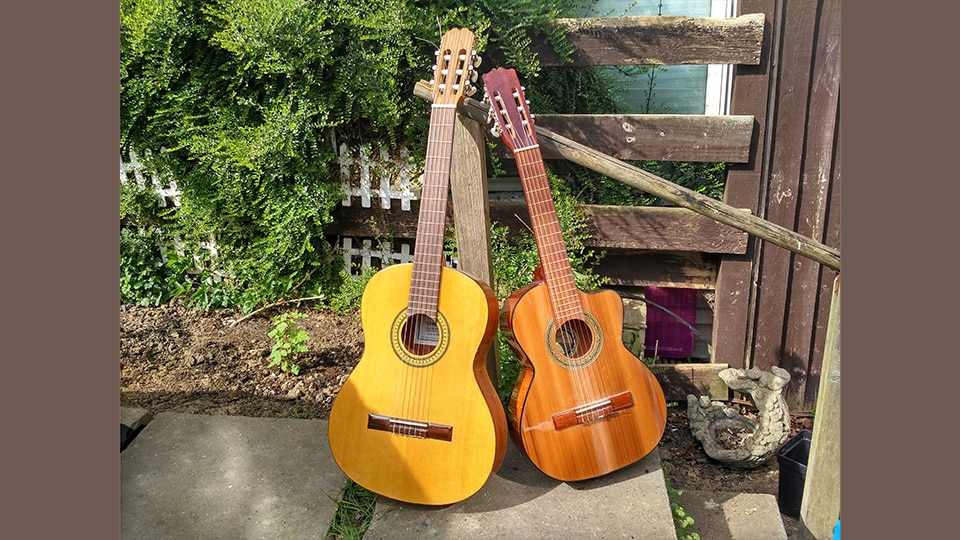By Leila Abdul-Rauf
You might be wondering why the guitar pictured above on the right looks smaller than the guitar on the left. It's a special type of guitar called a requinto – a Spanish and Portuguese word referring to a smaller and higher-pitched version of any instrument. Roughly 4/5ths the size of a classical guitar, a nylon-string requinto is tuned a fourth interval higher than standard tuning (A-D-G-C-E-A) and it's the lead melodic instrument in a bachata band.
In derecho, the requinto part usually riffs off the vocal melody, and can vary greatly depending on where it is in a song. Like the percussion instruments, the requinto plays one note for every upbeat and downbeat in a measure, or eight notes total for every measure. In the verses, a requinto riff is often an ascending or descending arpeggiated chord, as in the Romeo Santos song "You." Listen for the distinctive requinto part at the one-minute mark.
The rhythm guitar, or segunda, is usually a standard-sized acoustic guitar and plays a more defined pattern in the derecho than the lead guitar does. Segunda plays on all four upbeats and downbeats, with low "bass" notes on downbeats one, three and four. In "You," the segunda player makes its entrance at 0:17, strumming all of the upbeats and the second downbeat, creating a syncopated feel against the percussion, almost like what you would hear in a ska song. To mix up the rhythm even further, the bass guitar also enters at 0:17 with its own pattern in the derecho. It matches the segunda's bass note rhythms on downbeats one, three, and four, but drops the second downbeat, keeping just the pick-up into the third downbeat:
The previous installment explained how the bongos and güira change their rhythmic patterns when transitioning from the derecho into the majao. The segunda and bass, however, maintain the same rhythms in the majao – which starts at 1:17 in "You." A string of electric lead guitar solos come in at 2:07, and that's when the rhythm changes up dramatically, letting you know you've reached the mambo section of the song – you'll hear continuous fills in the bongos, and even some bass slapping and swooping!
Romeo Santos fuses bachata with hip-hop and R&B elements – Usher and Drake make guest appearances on some of his songs – while still honoring bachata's traditional structure. It's an inventive blend of the old with the new.
Leila Abdul-Rauf is a multi-instrumentalist and composer based in Oakland, CA. Leila is guitarist and vocalist for metal bands Vastum, Hammers of Misfortune, and ethereal post-punk band Terebellum. She also composes and produces ambient music under her own name, with electronic trio Ionophore, and with synth-folk duo Fyrhtu. She has toured internationally and is a private guitar and voice teacher in her spare time.
"A classical guitar (left) and a requinto guitar (right)" by Jo Dusepo is licensed under CC BY-SA 4.0.



